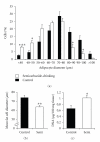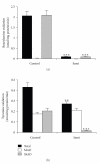Oral Administration of Semicarbazide Limits Weight Gain together with Inhibition of Fat Deposition and of Primary Amine Oxidase Activity in Adipose Tissue
- PMID: 21331292
- PMCID: PMC3038600
- DOI: 10.1155/2011/475786
Oral Administration of Semicarbazide Limits Weight Gain together with Inhibition of Fat Deposition and of Primary Amine Oxidase Activity in Adipose Tissue
Abstract
An enzyme hitherto named semicarbazide-sensitive amine oxidase (SSAO), involved in the oxidation of primary amines, is abundantly expressed in adipocytes. Although SSAO physiological functions remain unclear, several molecules inhibiting its activity have been described to limit fat accumulation in preadipocyte cultures or to reduce body weight gain in obese rodents. Here, we studied whether oral administration of semicarbazide, a prototypical SSAO inhibitor, limits fat deposition in mice. Prolonged treatment with semicarbazide at 0.125% in drinking water limited food and water consumption, hampered weight gain, and deeply impaired fat deposition. The adiposomatic index was reduced by 31%, while body mass was reduced by 15%. Such treatment completely inhibited SSAO, but did not alter MAO activity in white adipose tissue. Consequently, the insulin-like action of the SSAO substrate benzylamine on glucose transport was abolished in adipocytes from semicarbazide-drinking mice, while their insulin sensitivity was not altered. Although semicarbazide is currently considered as a food contaminant with deleterious effects, the SSAO inhibition it induces appears as a novel concept to modulate adipose tissue development, which is promising for antiobesity drug discovery.
Figures





Similar articles
-
Limitation of adipose tissue enlargement in rats chronically treated with semicarbazide-sensitive amine oxidase and monoamine oxidase inhibitors.Pharmacol Res. 2008 Jun;57(6):426-34. doi: 10.1016/j.phrs.2008.04.005. Epub 2008 Apr 24. Pharmacol Res. 2008. PMID: 18539478
-
Reduction of fat deposition by combined inhibition of monoamine oxidases and semicarbazide-sensitive amine oxidases in obese Zucker rats.Pharmacol Res. 2007 Dec;56(6):522-30. doi: 10.1016/j.phrs.2007.09.016. Epub 2007 Sep 26. Pharmacol Res. 2007. PMID: 17977742
-
Prolonged treatment with aminoguanidine strongly inhibits adipocyte semicarbazide-sensitive amine oxidase and slightly reduces fat deposition in obese Zucker rats.Pharmacol Res. 2007 Jul;56(1):70-9. doi: 10.1016/j.phrs.2007.04.002. Epub 2007 May 1. Pharmacol Res. 2007. PMID: 17548204
-
Semicarbazide-sensitive amine oxidase (SSAO) in the brain.Neurochem Res. 2002 Apr;27(4):263-8. doi: 10.1023/a:1014911209925. Neurochem Res. 2002. PMID: 11958526 Review.
-
Selective inhibitors of membrane-bound semicarbazide-sensitive amine oxidase (SSAO) activity in mammalian tissues.Neurotoxicology. 2004 Jan;25(1-2):325-35. doi: 10.1016/S0161-813X(03)00118-9. Neurotoxicology. 2004. PMID: 14697907 Review.
Cited by
-
Anatomical distribution of primary amine oxidase activity in four adipose depots and plasma of severely obese women with or without a dysmetabolic profile.J Physiol Biochem. 2016 Aug;73(3):475-486. doi: 10.1007/s13105-016-0526-0. Epub 2016 Oct 21. J Physiol Biochem. 2016. PMID: 27766585
-
Attenuation of Weight Gain and Prevention of Associated Pathologies by Inhibiting SSAO.Nutrients. 2020 Jan 9;12(1):184. doi: 10.3390/nu12010184. Nutrients. 2020. PMID: 31936548 Free PMC article. Review.
-
Glitazones inhibit human monoamine oxidase but their anti-inflammatory actions are not mediated by VAP-1/semicarbazide-sensitive amine oxidase inhibition.J Physiol Biochem. 2015 Sep;71(3):487-96. doi: 10.1007/s13105-014-0379-3. Epub 2015 Jan 9. J Physiol Biochem. 2015. PMID: 25572340
-
Zinc-α2-glycoprotein as an inhibitor of amine oxidase copper-containing 3.Open Biol. 2020 Apr;10(4):190035. doi: 10.1098/rsob.190035. Epub 2020 Apr 22. Open Biol. 2020. PMID: 32315567 Free PMC article.
-
Past, Present and Future Anti-Obesity Effects of Flavin-Containing and/or Copper-Containing Amine Oxidase Inhibitors.Medicines (Basel). 2019 Jan 15;6(1):9. doi: 10.3390/medicines6010009. Medicines (Basel). 2019. PMID: 30650583 Free PMC article. Review.
References
-
- Yu PH, Wang M, Fan H, Deng Y, Gubisne-Haberle D. Involvement of SSAO-mediated deamination in adipose glucose transport and weight gain in obese diabetic KKAy mice. American Journal of Physiology. 2004;286(4):E634–E641. - PubMed
-
- Mercier N, El Hadri K, Osborne-Pellegrin M, et al. Modifications of arterial phenotype in response to amine oxidase inhibition by semicarbazide. Hypertension. 2007;50(1):234–241. - PubMed
-
- Mercier N, Kakou A, Challande P, Lacolley P, Osborne-Pellegrin M. Comparison of the effects of semicarbazide and β-aminopropionitrile on the arterial extracellular matrix in the Brown Norway rat. Toxicology and Applied Pharmacology. 2009;239(3):258–267. - PubMed
-
- Yu PH, Zuo DM. Aminoguanidine inhibits semicarbazide-sensitive amine oxidase activity: implications for advanced glycation and diabetic complications. Diabetologia. 1997;40(11):1243–1250. - PubMed
-
- Nilsson BO. Biological effects of aminoguanidine: an update. Inflammation Research. 1999;48(10):509–515. - PubMed
LinkOut - more resources
Full Text Sources

